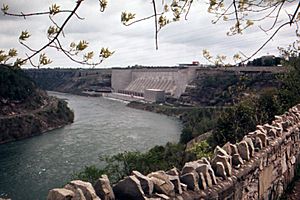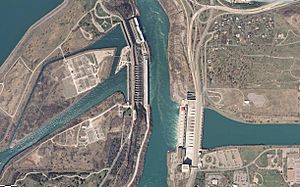Robert Moses Niagara Power Plant facts for kids
Quick facts for kids Robert Moses Niagara Hydroelectric Power Station |
|
|---|---|
 |
|
| Country | United States |
| Location | Lewiston, New York |
| Coordinates | 43°08′35″N 79°02′23″W / 43.14306°N 79.03972°W |
| Purpose | Power |
| Status | Operational |
| Construction began | 1957 |
| Opening date | 1961 |
| Construction cost | US$800 million (1957) |
| Owner(s) | New York Power Authority |
| Dam and spillways | |
| Type of dam | Gravity dam |
| Impounds | Niagara River |
| Reservoir | |
| Creates | Moses Niagara Power Plant forebay |
| Total capacity | 740,000,000 US gal (2.8×109 L; 620,000,000 imp gal) |
| Power station | |
| Commission date | 1961 |
| Type | Conventional |
| Turbines | 13 |
| Installed capacity | 2,675 MW (3,587,000 hp) |
| Website http://www.nypa.gov/facilities/niagara.htm |
|
| Works in conjunction with the Lewiston Pump-Generating Plant | |
The Robert Moses Niagara Hydroelectric Power Station is a huge power plant in Lewiston, New York. It is very close to the famous Niagara Falls. This plant makes electricity using the power of water, which is called hydroelectricity.
The power station is owned and run by the New York Power Authority (NYPA). It takes water from the Niagara River above Niagara Falls. Then, it sends the water back into the lower part of the river, closer to Lake Ontario. The plant has 13 large generators that can produce a lot of power, about 2,675 megawatts.
The plant is named after Robert Moses, a famous city planner from New York. It was built to replace an older power plant, the Schoellkopf Power Station, which collapsed in 1956. Across the river in Canada, there's a similar plant called the Sir Adam Beck Hydroelectric Power Stations.
Contents
How the Power Plant Was Built
Early Ideas for Power
The area where the Robert Moses Niagara Power Plant now stands has a long history. Back in 1805, two brothers, Augustus and Peter Porter, bought the American Falls. They also got rights to the fast-moving water above the falls. They dreamed of building a canal and a power plant, but they passed away before they could make it happen. Other companies tried similar projects later, but they also faced challenges.
In 1853, a company called the Niagara Falls Hydraulic Power and Manufacturing Company was formed. By 1861, they finished building a canal that was 35 feet wide and 8 feet deep. Their first powerhouse opened in 1874, but it didn't make much electricity.
Schoellkopf's Power Plants
In 1877, a person named Jacob F. Schoellkopf bought the canal and the water rights for $71,000. He made the canal better and started using the powerhouse to sell electricity. His company built Schoellkopf Power Station No. 1 in 1881. This plant worked until 1904.
Later, in 1891, Schoellkopf Power Station No. 2 opened. It was built right in front of the first one, in the deep gorge below the falls. This new plant had a much higher water drop of 210 feet, which helped it make more power. More sections, Schoellkopf Stations No. 3A and 3B, were added in 1914 and 1918.
Another company, the Niagara Falls Power Company, built the Adams Power Plant in 1886. Between 1900 and 1904, they added Powerhouse No. 2, bringing their total to 11 generators.
During World War I in 1918, these power companies joined together to form the Niagara Falls Power Company. From 1921 to 1924, they built Schoellkopf Station No. 3C. This section had three powerful generators. Overall, the Schoellkopf Power Stations had 19 generators and could produce a lot of power.
The Schoellkopf Collapse
On June 7, 1956, a big problem happened. Water started leaking into a back wall of the Schoellkopf Power Station. This caused two-thirds of the plant (sections 3b and 3c) to collapse. One worker sadly died, and the damage cost about $100 million.
Building the Robert Moses Plant
After the Schoellkopf plant collapsed, the New York Power Authority (NYPA) decided to build a new, much bigger power plant. This new plant would cost $800 million and produce 2.4 gigawatts of power. At first, it was called the Niagara Power Project. Later, it was named after Robert Moses, who was in charge of the NYPA.
In 1957, the United States Congress approved the project. Construction started that same year. To build the plant, the NYPA needed to get rights to 550 acres of land from the Tuscarora Indian Reservation. This land was needed for a new, large reservoir. In 1960, the U.S. Supreme Court made a decision that allowed NYPA to use the land.
During the building process, workers dug out over 12 million cubic yards of rock. Sadly, twenty workers died during construction. The plant was finished in 1961. When it opened, it was the largest hydropower facility in the Western world. In 2017, the plant was added to the National Register of Historic Places because of its importance.
How the Lewiston Pump-Generating Plant Works
| Lewiston Pump-Generating Plant | |
|---|---|
| Country | United States |
| Location | Lewiston, New York |
| Purpose | Power |
| Status | Operational |
| Construction began | 1957 |
| Opening date | 1961 |
| Construction cost | $48.72 million USD (1962) |
| Owner(s) | New York Power Authority |
| Dam and spillways | |
| Type of dam | Gravity dam |
| Impounds | Moses Niagara Power Plant forebay |
| Reservoir | |
| Creates | Lewiston Reservoir |
| Total capacity | 22,000,000,000 US gal (8.3×1010 L; 1.8×1010 imp gal) |
| Surface area | 1,900 acres (770 ha) |
| Power station | |
| Coordinates | 43°08′35″N 79°01′18.4″W / 43.14306°N 79.021778°W |
| Commission date | 1961 |
| Type | Pumped-storage |
| Turbines | 12 × 20 MW |
| Installed capacity | 240 |
| Website http://www.nypa.gov/facilities/niagara.htm |
|
| Works in conjunction with the Robert Moses Niagara Power Plant | |
The Lewiston Pump-Generating Plant is a special part of the power system. It has a Dam that holds back a man-made reservoir called the Lewiston Reservoir. This reservoir stores water before it goes to the Robert Moses Power Station.
Water first enters a holding area (called a forebay) through tunnels from the Niagara River. This water is controlled by the International Control Dam upstream from the natural falls. From the forebay, water can either be pumped up into the Lewiston Reservoir or sent directly down to the Robert Moses Power Station turbines.
The Lewiston Pump-Generating Plant has 12 special pump-generators. These can make 240 megawatts of electricity when water is released from the upper reservoir.
Storing Energy with Water
At night, when people use less electricity, two large tunnels send a lot of water from the Niagara River to the forebay. The electricity made by the Moses plant at night is used to power pumps. These pumps push water from the forebay up into the Lewiston Reservoir. Water is pumped at night because there is less demand for electricity. Also, less water can be taken from the river during the day to keep Niagara Falls looking beautiful.
During the day, when more electricity is needed, water is released from the Lewiston Reservoir. This water flows through the pump-generators in the Lewiston Dam, making electricity. Then, this water flows into the forebay and goes through the turbines of the Moses plant, making even more electricity. It's like the water is "used twice" to make power! This system is a type of pumped-storage hydroelectricity. Engineers learned this idea from a similar system built in Canada in the 1950s.
This system is great for storing large amounts of energy. At night, the energy from the moving water is turned into electricity at the Moses plant. Some of that electricity is then used to pump water uphill into the reservoir, storing energy. During the day, this stored energy is released as water flows downhill, making electricity at both the Lewiston Dam and the Moses Dam.
Since 2012, the Lewiston pump-generating plant has been getting a big upgrade. This $460 million project will make the plant work even better and last longer. The Robert Moses Plant itself was also updated in 2006.
Environmental Considerations
In the mid-1980s, there were plans to expand the power plant site. However, the project was stopped because harmful chemicals were found underground. These chemicals had been dumped there by chemical companies that owned the land before. Testing near the Lewiston Reservoir still shows some contamination. Because of this, it is not safe to eat fish caught there.
Niagara Power Visitors Center
The Niagara Power Visitors Center is a great place to learn about hydroelectricity. It's located about four miles downstream from Niagara Falls. The center has an observation deck where you can see the Niagara Gorge. Inside, there are fun, interactive exhibits that teach you all about how hydroelectricity works and the history of power in the Niagara area.



